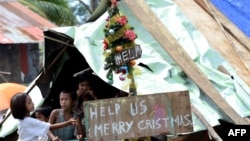MANILA —
With thousands of people leaving the typhoon-affected central Philippines, social service agencies are being vigilant against exploitation and human trafficking of some of the most vulnerable survivors.
A social worker calls out logistics for food delivery to recent arrivals at the Villamor Air Base grandstand. After eating a meal, this fresh batch of evacuees will register with the Social Welfare and Development department.
The department is seeing to their immediate basic needs and tracking whether they have family in the area. Social Welfare Specialist Foilan Maglaya said the department is also keeping an eye out for any attempts by people to take advantage of the typhoon survivors.
“We have to ensure that the children with the family, is their real child because we want to prevent human trafficking, child trafficking. We don’t want women to end up with traffickers,” Maglaya said.
Social welfare officials said so far, they have not had any such cases in their assessments. But they said every day people approach to see if they could hire domestic helpers from among the evacuees.
“We just discouraged them because right now being household help is not the most appropriate employment for the survivors because they need to be debriefed. They need to be attended to psychologically because they went through so much trauma. So they need to be well before they can be employed again." said Doan Foronda, social welfare officer.
The evacuees who arrive in Villamor come on C130 planes that depart from Tacloban, the city that took the worst of Typhoon Haiyan’s wrath. Tacloban and nearby coastal towns in Leyte province experienced a massive storm surge that caused a tsunami-like effect, killing some thousands of people. In nearby Samar province, towns were almost completely obliterated by Haiyan’s powerful winds.
The United Nations Children’s Fund (UNICEF) is checking with local officials in the worst hit cities for reports of children left alone. UNICEF Manila Child Protection chief Sarah Norton-Staal says there are some reports of orphaned children, but authorities are still working to estimate their number.
Norton-Staal said in past disasters, such as Typhoon Bopha last year, they have seen a 10 percent spike in child trafficking.
“It’s really just because of the destruction of local services. The local capacity to handle these cases is diminished and people’s livelihoods put them at greater risk and vulnerability for trafficking,” she explained.
She said UNICEF is training local government officials and other social workers how to help families reunite through a mobile device registration system for children. Norton-Staal said there is significant awareness of the potential for trafficking and the training which started this week has been heavily attended.
Maglaya of the Social Welfare department said at the air base messages in the local dialect are being broadcast regularly to remind survivors to keep a lookout for possible exploitation.
A social worker calls out logistics for food delivery to recent arrivals at the Villamor Air Base grandstand. After eating a meal, this fresh batch of evacuees will register with the Social Welfare and Development department.
The department is seeing to their immediate basic needs and tracking whether they have family in the area. Social Welfare Specialist Foilan Maglaya said the department is also keeping an eye out for any attempts by people to take advantage of the typhoon survivors.
“We have to ensure that the children with the family, is their real child because we want to prevent human trafficking, child trafficking. We don’t want women to end up with traffickers,” Maglaya said.
Social welfare officials said so far, they have not had any such cases in their assessments. But they said every day people approach to see if they could hire domestic helpers from among the evacuees.
“We just discouraged them because right now being household help is not the most appropriate employment for the survivors because they need to be debriefed. They need to be attended to psychologically because they went through so much trauma. So they need to be well before they can be employed again." said Doan Foronda, social welfare officer.
The evacuees who arrive in Villamor come on C130 planes that depart from Tacloban, the city that took the worst of Typhoon Haiyan’s wrath. Tacloban and nearby coastal towns in Leyte province experienced a massive storm surge that caused a tsunami-like effect, killing some thousands of people. In nearby Samar province, towns were almost completely obliterated by Haiyan’s powerful winds.
The United Nations Children’s Fund (UNICEF) is checking with local officials in the worst hit cities for reports of children left alone. UNICEF Manila Child Protection chief Sarah Norton-Staal says there are some reports of orphaned children, but authorities are still working to estimate their number.
Norton-Staal said in past disasters, such as Typhoon Bopha last year, they have seen a 10 percent spike in child trafficking.
“It’s really just because of the destruction of local services. The local capacity to handle these cases is diminished and people’s livelihoods put them at greater risk and vulnerability for trafficking,” she explained.
She said UNICEF is training local government officials and other social workers how to help families reunite through a mobile device registration system for children. Norton-Staal said there is significant awareness of the potential for trafficking and the training which started this week has been heavily attended.
Maglaya of the Social Welfare department said at the air base messages in the local dialect are being broadcast regularly to remind survivors to keep a lookout for possible exploitation.












